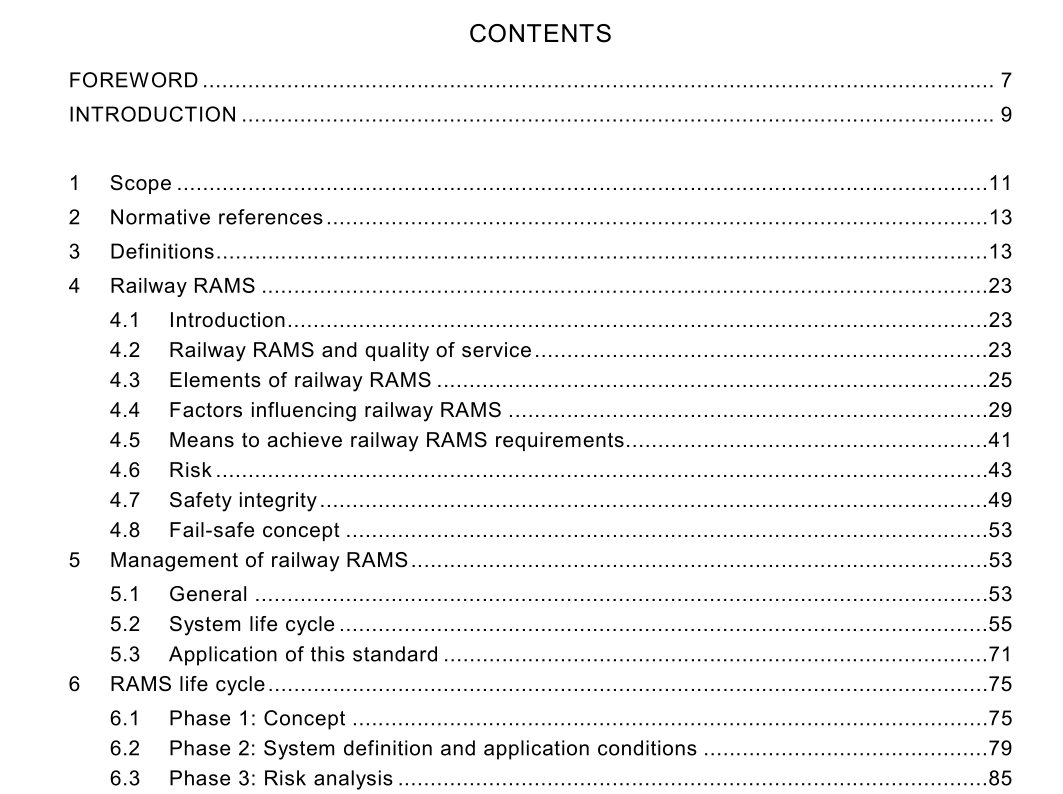IEC 62278 pdf download

IEC 62278 pdf download,Railway applications – Specification and demonstration of reliability, availability, maintainability and safety (RAMS)
1 Scope
1.1 This International Standard – defines RAMS in terms of reliability, availability, maintainability and safety and their interaction; – defines a process, based on the system life cycle and tasks within it, for managing RAMS; – enables conflicts between RAMS elements to be controlled and managed effectively; – defines a systematic process for specifying requirements for RAMS and demonstrating that these requirements are achieved; – addresses railway specifics; – does not define RAMS targets, quantities, requirements or solutions for specific railway applications; – does not specify requirements for ensuring system security; – does not define rules or processes pertaining to the certification of railway products against the requirements of this standard; – does not define an approval process by the safety regulatory authority. 1.2 This International Standard is applicable – to the specification and demonstration of RAMS for all railway applications and at all levels of such an application, as appropriate, from complete railway routes to major systems within a railway route, and to individual and combined sub-systems and components within these major systems, including those containing software; in particular • to new systems, • to new systems integrated into existing systems in operation prior to the creation of this standard, although it is not generally applicable to other aspects of the existing system, • to modifications of existing systems in operation prior to the creation of this standard; although it is not generally applicable to other aspects of the existing system; − at all relevant phases of the life cycle of an application; − for use by Railway Authorities and railway support industry. NOTE Guidance on the applicability is given in the requirements of this standard.
3 Definitions
For the purposes of this standard, the following definitions apply. 3.1 apportionment process whereby the RAMS elements for a system are sub-divided between the various items which comprise the system to provide individual targets 3.2 assessment undertaking of an investigation in order to arrive at a judgement, based on evidence, of the suitability of a product 3.3 audit systematic and independent examination to determine whether the procedures specific to the requirements of a product comply with the planned arrangements, are implemented effectively and are suitable to achieve the specified objectives 3.4 availability ability of a product to be in a state to perform a required function under given conditions at a given instant of time or over a given time interval assuming that the required external resources are provided 3.5 commissioning collective term for the activities undertaken to prepare a system or product prior to demonstrating that it meets its specified requirements 3.6 common cause failure failure which is the result of an event(s) which causes a coincidence of failure states of two or more components leading to a system failing to perform its required function 3.7 compliance demonstration that a characteristic or property of a product satisfies the stated requirements. 3.8 configuration management discipline applying technical and administrative direction and surveillance to identify and document the functional and physical characteristics of a configuration item, control change to those characteristics, record and report change processing and implementation status and verify compliance with specified requirements 3.9 corrective maintenance maintenance carried out after fault recognition and intended to put a product into a state in which it can perform a required function 3.10 dependent failure failure of a set of events, the probability of which cannot be expressed as the simple product of the unconditional probabilities of the individual events 3.11 down time time interval during which a product is in a down state [IEC 60050(191), modified] 3.12 failure cause circumstances during design, manufacture or use which have led to a failure [IEC 60050(191)] 3.13 failure mode predicted or observed results of a failure cause on a stated item in relation to the operating conditions at the time of the failure 3.14 failure rate limit, if this exists, of the ratio of the conditional probability that the instant of time, T, of a failure of a product falls within a given time interval (t, t+∆t) and the length of this interval, ∆t, when ∆t tends towards zero, given that the item is in an up state at the start of the time interval NOTE For applications where distance travelled or number of cycles of operation is more relevant than time then the unit of time may be replaced by the unit of distance or cycles, as appropriate.









